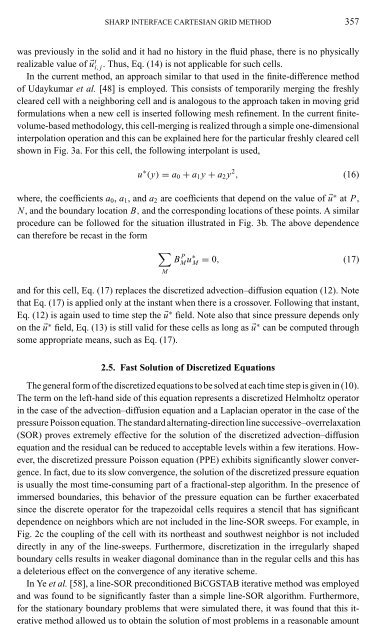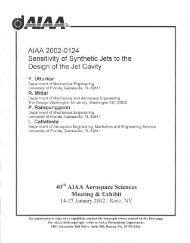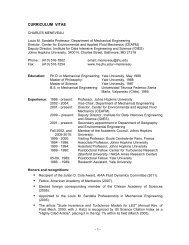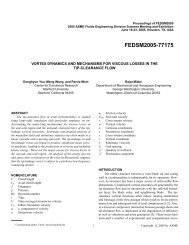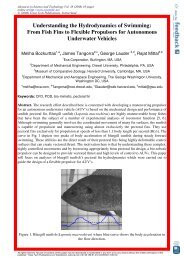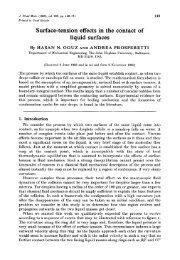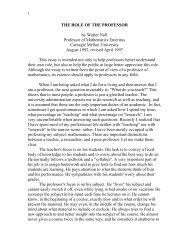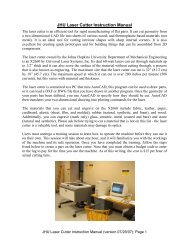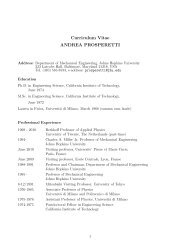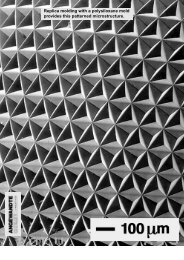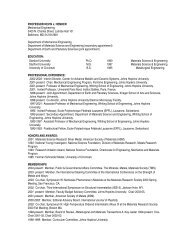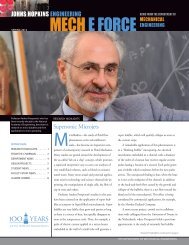A Sharp Interface Cartesian Grid Method for Simulating Flows with ...
A Sharp Interface Cartesian Grid Method for Simulating Flows with ...
A Sharp Interface Cartesian Grid Method for Simulating Flows with ...
You also want an ePaper? Increase the reach of your titles
YUMPU automatically turns print PDFs into web optimized ePapers that Google loves.
SHARP INTERFACE CARTESIAN GRID METHOD 357<br />
was previously in the solid and it had no history in the fluid phase, there is no physically<br />
realizable value of ⃗u i, t j . Thus, Eq. (14) is not applicable <strong>for</strong> such cells.<br />
In the current method, an approach similar to that used in the finite-difference method<br />
of Udaykumar et al. [48] is employed. This consists of temporarily merging the freshly<br />
cleared cell <strong>with</strong> a neighboring cell and is analogous to the approach taken in moving grid<br />
<strong>for</strong>mulations when a new cell is inserted following mesh refinement. In the current finitevolume-based<br />
methodology, this cell-merging is realized through a simple one-dimensional<br />
interpolation operation and this can be explained here <strong>for</strong> the particular freshly cleared cell<br />
shown in Fig. 3a. For this cell, the following interpolant is used,<br />
u ∗ (y) = a 0 + a 1 y + a 2 y 2 , (16)<br />
where, the coefficients a 0 , a 1 , and a 2 are coefficients that depend on the value of ⃗u ∗ at P,<br />
N, and the boundary location B, and the corresponding locations of these points. A similar<br />
procedure can be followed <strong>for</strong> the situation illustrated in Fig. 3b. The above dependence<br />
can there<strong>for</strong>e be recast in the <strong>for</strong>m<br />
∑<br />
= 0, (17)<br />
M<br />
B P M u∗ M<br />
and <strong>for</strong> this cell, Eq. (17) replaces the discretized advection–diffusion equation (12). Note<br />
that Eq. (17) is applied only at the instant when there is a crossover. Following that instant,<br />
Eq. (12) is again used to time step the ⃗u ∗ field. Note also that since pressure depends only<br />
on the ⃗u ∗ field, Eq. (13) is still valid <strong>for</strong> these cells as long as ⃗u ∗ can be computed through<br />
some appropriate means, such as Eq. (17).<br />
2.5. Fast Solution of Discretized Equations<br />
The general <strong>for</strong>m of the discretized equations to be solved at each time step is given in (10).<br />
The term on the left-hand side of this equation represents a discretized Helmholtz operator<br />
in the case of the advection–diffusion equation and a Laplacian operator in the case of the<br />
pressure Poisson equation. The standard alternating-direction line successive–overrelaxation<br />
(SOR) proves extremely effective <strong>for</strong> the solution of the discretized advection–diffusion<br />
equation and the residual can be reduced to acceptable levels <strong>with</strong>in a few iterations. However,<br />
the discretized pressure Poisson equation (PPE) exhibits significantly slower convergence.<br />
In fact, due to its slow convergence, the solution of the discretized pressure equation<br />
is usually the most time-consuming part of a fractional-step algorithm. In the presence of<br />
immersed boundaries, this behavior of the pressure equation can be further exacerbated<br />
since the discrete operator <strong>for</strong> the trapezoidal cells requires a stencil that has significant<br />
dependence on neighbors which are not included in the line-SOR sweeps. For example, in<br />
Fig. 2c the coupling of the cell <strong>with</strong> its northeast and southwest neighbor is not included<br />
directly in any of the line-sweeps. Furthermore, discretization in the irregularly shaped<br />
boundary cells results in weaker diagonal dominance than in the regular cells and this has<br />
a deleterious effect on the convergence of any iterative scheme.<br />
In Ye et al. [58], a line-SOR preconditioned BiCGSTAB iterative method was employed<br />
and was found to be significantly faster than a simple line-SOR algorithm. Furthermore,<br />
<strong>for</strong> the stationary boundary problems that were simulated there, it was found that this iterative<br />
method allowed us to obtain the solution of most problems in a reasonable amount


